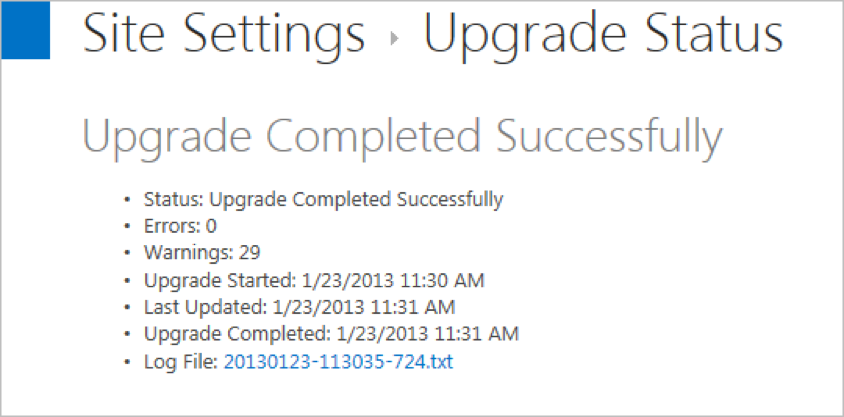Migrate BrightWork 2010 to BrightWork 2013
This article describes some things you will need to be aware of when upgrading a BrightWork for SharePoint 2010 installation to a BrightWork for SharePoint 2013 installation.
Note: It is important that you read and fully understand everything in this section before upgrading.
Before Upgrading
Supported BrightWork on SharePoint 2010 Version
You can only update from the last version of BrightWork for SharePoint 2010, i.e. BrightWork 12 (marketing release number) or Version 14.4 (technical release number).
To find out what version you are on, open the BrightWork Help. The marketing release number will be displayed at the top of the Welcome page. The technical release number will be displayed at the bottom of the Welcome page.
If you are on a prior release you will have to upgrade to the supported version.
Upgrade Method
The only upgrade method that is supported is the database-attach one. Please see here for more information on this.
Disable Inline Editing in List Views
Inline editing in list views is not supported in SharePoint 2013 views. If you upgrade a view that had inline editing enabled in 2010, it will not function like a standard view in SharePoint 2013, for example, the new item and quick edit options will not be available.
See http://www.manageprojectsonsharepoint.com/blog/2013/05/24/sharepoint-2013-upgrade-powershell-update-view/ for a blog post on how to globally disable inline editing before backing up the database that is to be migrated.
Review the What's New
Click here to review the What's New for BrightWork on SharePoint 2013.
In particular, you should review the Deprecated Features section.
BrightWork 14 Solution
You will need to install a BrightWork 14 solution.
Install April 2013 Cumulative Update
Customers who upgrade their BrightWork for SharePoint 2010 install to a BrightWork for SharePoint 2013 install will need to install the April CU for SharePoint 2013. This can be done before or after the upgrade. See below for the links to download the appropriate version.
After Upgrading Database
Upgrade Site Collection to 2013 Mode
BrightWork on SharePoint 2013 does not support 2010 Mode. This means if you navigate to the site collection, or run the site collection health checks, immediately after upgrading the database, you will experience lots of errors. To make the site collection usable, you must upgrade it to 2013 Mode.
There are two ways to upgrade your site collection to 2013 mode:
- Via PowerShell
- Via the SharePoint UI
Upgrade Site Collection via PowerShell
- Login to the SharePoint 2013 server.
- Right-click on the SharePoint 2013 Management Shell and click Run as administrator.
-
Run this command:
Upgrade-SPSite <SiteCollectionURL> -VersionUpgrade -Verbose
Upgrade Site Collection via SharePoint UI
-
Navigate to this location:
http://SERVER-NAME/sites/SITE-COLLECTION-NAME/_layouts/15/siteupgrade.aspx - Click Upgrade this Site Collection.
- Click I'm ready.
After the upgrade is complete, this message will display:

Copy Custom Image Files
If you have added any files to the default images folder on the server (e.g. for Choice Indicator Icon Columns, Number Indicator Icon Columns etc.), you will have to manually copy these files from the old 2010 server to the new 2013 server to the same location (you will have to create this location).
Drive:\Program Files\Common Files\Microsoft Shared\web server extensions\15\template\images
Alternatively, you can copy the files to the default location for SharePoint 2013 and update the URLs in the relevant columns.
Drive:\Program Files\Common Files\Microsoft Shared\web server extensions\15\template\images
Upgraded Sites Limitations
For the best BrightWork on SharePoint 2013 experience, we recommend recreating your Project Office, Project Lite, Project Standard, Project Structured, and Work Tracker based templates using new site definitions.
If you decide to retain your old templates, you should be aware of the below limitations. Also, please see the What's New for other issues that may affect your installation.
SharePoint Tasks List
The Project Lite, Project Standard, Project Structured, and Work Tracker templates use the new SharePoint Project Tasks list that offers a better user interface and more reliable and improved syncing with Microsoft Project Professional 2013.
Templates and sites from 2010 will continue to use the old SharePoint Tasks list.
Timeline and Project Summary Web Parts
The Project Lite, Project Standard, Project Structured, and Work Tracker templates now include the new SharePoint Timeline and Project Summary (called Task Summary in BrightWork) web parts.
These web parts require the new SharePoint 2013 Tasks list.
Promoted Links
The colourful Getting Started tiles from BrightWork on SharePoint 2010 have been replaced with the new Promoted Links list and web part. This gives you greater control over the content of the tiles.